This fun and charming bookend project is a great craft for a golfer. Whether you are making these delightful bookends to give away, or to add a touch of charm to adorn your own tabletop or bookshelf, these wonderful DIY Golf Bookends will add style and a sense of whimsy to any home decor.
DIY Golf Bookends
If you are looking for more femine bookends, make these floral bookends!
This wooden box bird’s nest floral arrangement is also great tabletop decor (use an old cigar box!) or perhaps you might like to make these simple apothecary jars with seashells for your tabletop, dresser, or fireplace mantel decor!
Tips and variations for making these DIY Golf Bookends:
● Practice safety. If you do not know how to use a hacksaw, get someone who does know how to use it to make the cut for you.
● I am not responsible if you cut yourself. I had to put that disclaimer in there. See above.
● Salvation Army, a garage sale, Goodwill… all GREAT places to find used golf clubs for a few dollars. You may want to consider a righty and lefty if you can find them so your golf clubs are facing outward on the bookend (in publishing, they call it flowing out to white space… or so I learned about 35 years ago). If you are using someone’s old clubs, this is of course, not possible.
● You can draw a line to trace the board so that you can center your screw in that area.
● Hubby suggested an outside bracket for extra support. He also suggested routering out the area where the bracket would go for extra support so it would be flush inside the wood instead of outside the wood. My suggestion? Hold fewer books (yikes – he sure likes his tools!)
● A thin line of glue… whether Elmer’s or the E6000® Craft Adhesive placed down on the wood before screwing the wood together will also add strength.
● Add green felt to the bottom of the bookends to protect the surface. Honestly, in my opinion, this should never be an option; you should always attach felt so as not to scratch furniture or shelving.
DIY Golf Bookends Materials:
● Hacksaw
● Metal File
● Cordless Drill
● Sander with 220 Grit Paper (or just 220 Grit Paper and you sand by hand)
● Scissors
● Ruler
● Wood – Measured 3.25″ x 7″ x 5/8″. Used were four pieces of board 7″ long (think old fence post, pallets, leftover project wood)
● Foam Paintbrush
● Small Paintbrush
● Scissors or Paper Cutter
● E6000® Craft Adhesive
● 4 Wood Screws, about 1.5″
● 2 pieces 12×12 Scrapbook Paper – Grass
● Christmas Green Paint
● Thicket Paint
● Mod Podge
● 2 Golf Balls
● 2 Golf Clubs
● Green Felt
DIY Golf Bookends Directions:
● Use a hacksaw to trim your golf clubs.
● Hacksaws are inexpensive and come with the metal blade you will need to cut the golf clubs.
● The golf clubs used in this project are trimmed to 2″ from the end.
● Use a metal file to file down any rough metal edges that occurred when cutting the clubs.
● Set aside.
● Trim your boards to the length you desire for your bookends.
● The length of the wood used in this project is 7″ long and 3.25″ wide (based on the length of the cut golf clubs). The thickness of the wood was 5/8″ thick.
● Sand your wood with sandpaper where necessary. You want the wood to be smooth. Make sure you break the edges at the bottom of each cut piece of wood and sand it smooth.
● Wipe away dust.
● Drill pilot holes into the corner of your bottom piece of wood.
● Align your wood bottom flat to top bottom.
● Screw-in your screws.
Suggestions:
● You can draw a line to trace the board so that you can center your screw in that area.
● Hubby suggested an outside bracket for extra support. He also suggested routering out the area where the bracket would go for extra support so it would be flush inside the wood instead of outside the wood. My suggestion? Hold fewer books (yikes – he sure likes his tools!)
● A thin line of glue… whether Elmer’s or the E6000® Craft Adhesive placed down on the wood before screwing the wood together will also add strength.
● Paint your bookends with green acrylic paint and a paintbrush.
● Mix two colors together for a different, unique look. This look was achieved by mixing Christmas green paint and thicket paint together.
● Pay special attention to the sides of the wood. These will be exposed and not have a covering (the grass scrapbook paper or felt).
● Make sure the screws are on the downside (the bottom) of you bookends. Be mindful of that when you paint and apply the paper in the next step. If you are adding felt to the bottom of your bookends, that will cover the screws and you won’t have to paint that section.
● You don’t have to paint the area you are covering with the scrapbook paper (or felt) if you do not want to, but make certain there is a slight overlap of paint so no raw wood shows through if you do indeed decide not to paint the entire piece.
● Trim your scrapbook paper a little smaller than the actual size of the bookends. Use scissors or a paper trimmer.
● Apply a thin coat of Mod Podge to the wood with your foam paintbrush
● Apply a thin coat of Mod Podge to the scrapbook paper and place that scrapbook paper onto the coated wood. Having both the wood and the scrapbook paper coated allows you to move the paper around a bit for better placement before the Mod Podge begins to dry. Use the palm of your hand and fingers to smooth out the air bubbles and excess Mod Podge.
● Repeat on all four flat wood surfaces. Set aside to dry for about two hours.
● Cover the wood and paper with Mod Podge. Let set to dry, about 1 hour.
● Use your E6000® Craft Adhesive to affix the clubs and balls to the bookends at desired placement. These are probably not going to be centered. Try several positions before actually gluing, and always goes with what looks best to you!
● You’ll want to find an undisturbed space to set your bookends when you are finished so the glue can set up and dry as directed on the package. These were left on a table out of reach for two days before using to hold books.
● Optional: add green felt to the bottom of the bookends to protect the surface. Honestly, in my opinion, this should never be an option; you should always attach felt so as not to scratch furniture or shelving.
● This is the finished left side.
● This is the finished right side. If you can find clubs that face the opposite way, it would flow better. Drivers, wedges, woods will add more impact than say, a putter.
DIY Golf Bookends
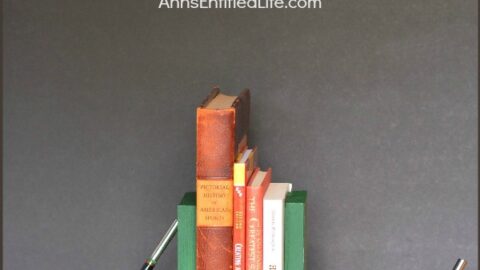
DIY Golf Bookends. This fun and charming bookend project is a great craft for a golfer. Whether you are making these delightful bookends to give away, or to add a touch of charm to adorn your own tabletop or bookshelf, these wonderful DIY Golf Bookends will add style and a sense of whimsy to any home decor.
Materials
- Sander with 220 Grit Paper (or just 220 Grit Paper and you sand by hand)
- Wood – Measured 3.25″ x 7″ x 5/8″. Used were four pieces of board 7″ long (think old fence post, pallets, leftover project wood)
- E6000® Craft Adhesive
- 4 Wood Screws, about 1.5″
- 2 pieces 12×12 Scrapbook Paper – Grass
- Christmas Green Paint
- Thicket Paint Color
- Mod Podge
- 2 Golf Balls
- 2 Golf Clubs
- Green Felt
Tools
- Hacksaw
- Metal File
- Cordless Drill
- Sander with 220 Grit Paper (or just 220 Grit Paper and you sand by hand)
- Scissors
- Ruler
- Foam Paintbrush
- Small Paintbrush
Instructions
- Use a hacksaw to trim your golf clubs. Hacksaws are inexpensive and come with the metal blade you will need to cut the golf clubs.
- The golf clubs used in this project are trimmed to 2″ from the end.
- Use a metal file to file down any rough metal edges that occurred when cutting the clubs.
- Set aside.
- Trim your boards to the length you desire for your bookends.
- The length of the wood used in this project is 7″ long and 3.25″ wide (based on the length of the cut golf clubs). The thickness of the wood was 5/8″ thick.
- Sand your wood with sandpaper where necessary. You want the wood to be smooth. Make sure you break the edges at the bottom of each cut piece of wood and sand it smooth.
- Wipe away dust.
- Drill pilot holes into the corner of your bottom piece of wood.
- Align your wood bottom flat to top-bottom.
- Screw in your screws. Suggestions:
• You can draw a line to trace the board so that you can center your screw in that area.
• Hubby suggested an outside bracket for extra support. He also suggested routering out the area where the bracket would go for extra support so it would be flush inside the wood instead of outside the wood. My suggestion? Hold fewer books (yikes – he sure likes his tools!)
• A thin line of glue… whether Elmer’s or the E6000 placed down on the wood before screwing the wood together will also add strength. - Paint your bookends with green acrylic paint and a paintbrush.
- Mix two colors together for a different, unique look. This look was achieved by mixing Christmas Green Paint and Thicket Paint together.
- Pay special attention to the sides of the wood. These will be exposed and not have a covering (the grass scrapbook paper or felt).
- Make sure the screws are on the downside (the bottom) of your bookends. Be mindful of that when you paint and apply the paper in the next step. If you are adding felt to the bottom of your bookends, that will cover the screws and you won’t have to paint that section.
- You don’t have to paint the area you are covering with the scrapbook paper (or felt) if you do not want to, but make certain there is a slight overlap of paint so no raw wood shows through if you do indeed decide not to paint the entire piece.
- Trim your scrapbook paper a little smaller than the actual size of the bookends. Use scissors or a paper trimmer.
- Apply a thin coat of Mod Podge to the wood with your foam paintbrush.
- Apply a thin coat of Mod Podge to the scrapbook paper and place that scrapbook paper onto the coated wood. Having both the wood and the scrapbook paper coated allows you to move the paper around a bit for better placement before the Mod Podge begins to dry. Use the palm of your hand and fingers to smooth out the air bubbles and excess Mod Podge.
- Repeat on all four flat wood surfaces. Set aside to dry for about two hours.
- Cover the wood and paper with Mod Podge. Let set to dry, about 1 hour.
- Use your E6000® Craft Adhesive to affix the clubs and balls to the bookends at the desired placement. These are probably not going to be centered. Try several positions before actually gluing, and always goes with what looks best to you!
- You will want to find an undisturbed space to set your bookends when you are finished so the glue can set up and dry as directed on the package. These were left on a table out of reach for two days before using to hold books.
- Optional: add green felt to the bottom of the bookends to protect the surface. Honestly, in my opinion, this should never be an option; you should always attach felt so as not to scratch furniture or shelving.
- Display as desired.
Notes
If you can find clubs that face the opposite way, it would flow better. Drivers, wedges, woods will add more impact than say, a putter.
Recommended Products
As an Amazon Associate and member of other affiliate programs, I earn from qualifying purchases.
● If you enjoyed this post, be sure to sign up for the Ann’s Entitled Life weekly newsletter, and never miss another article!
● For more Craft posts on Ann’s Entitled Life, click here.
● For more Holiday posts on Ann’s Entitled Life, click here.

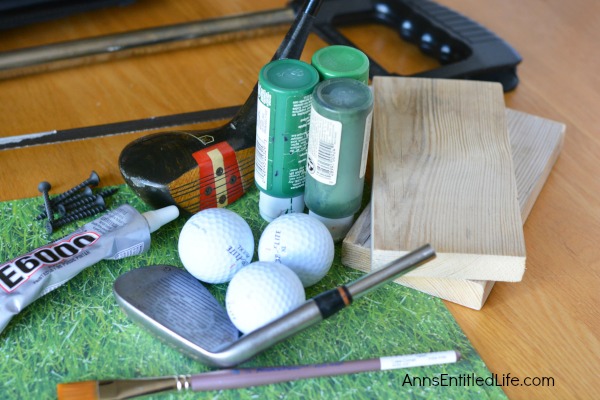
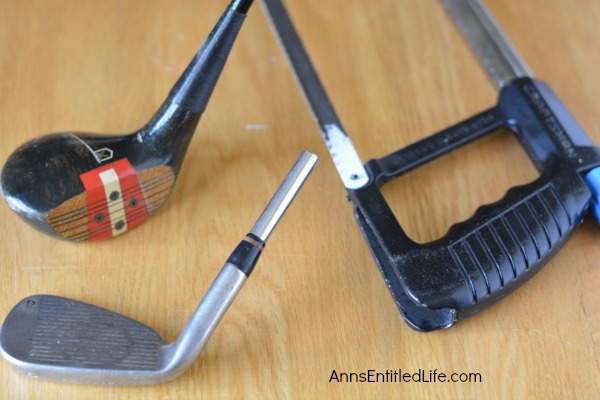
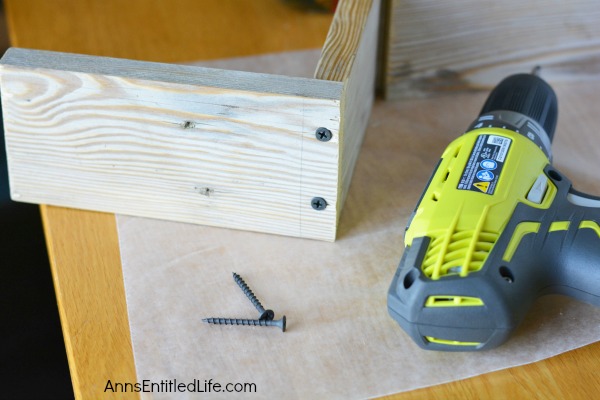
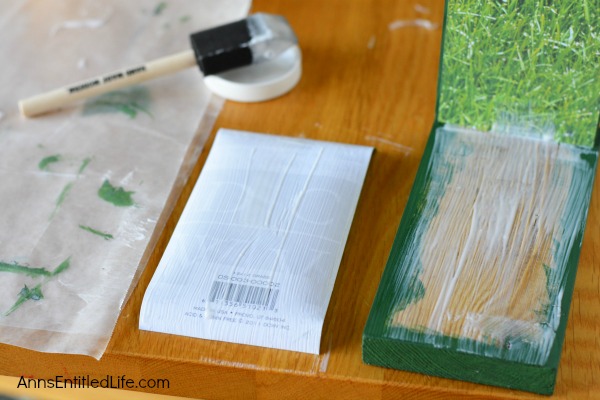
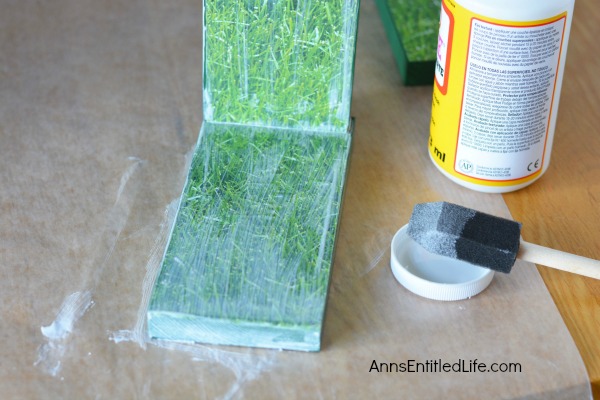
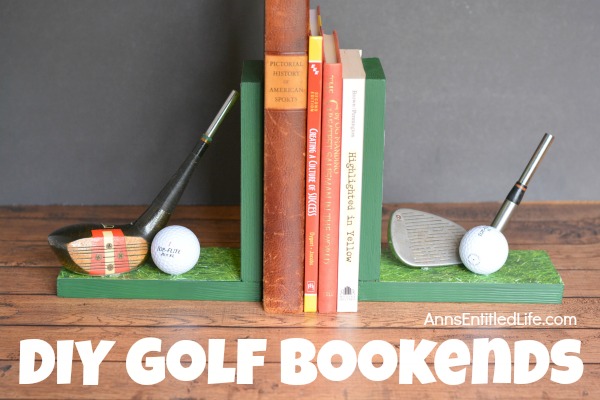
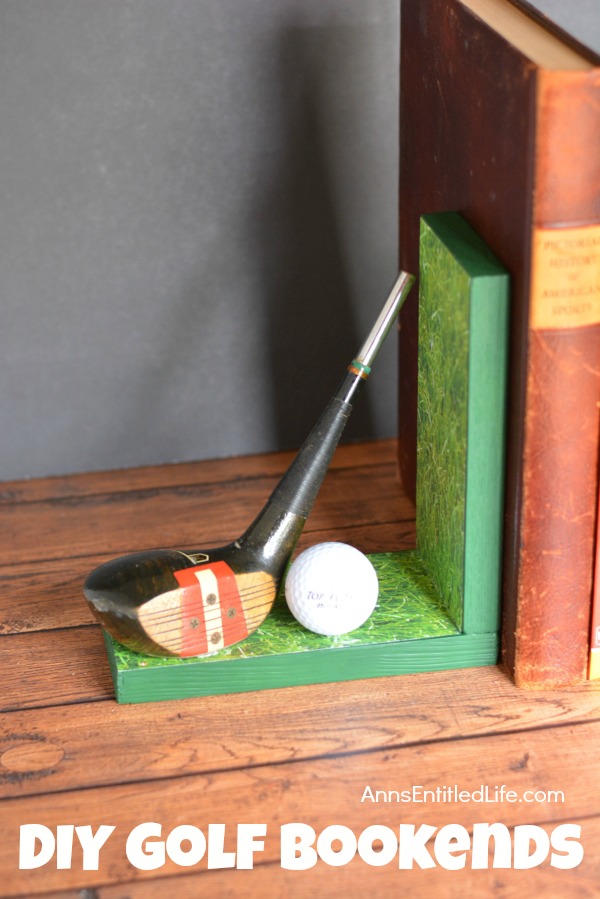
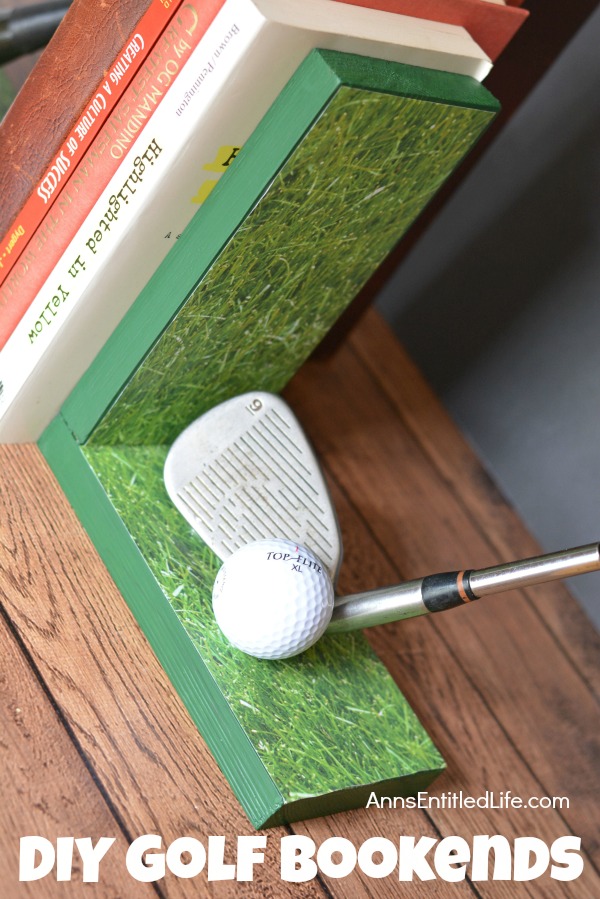
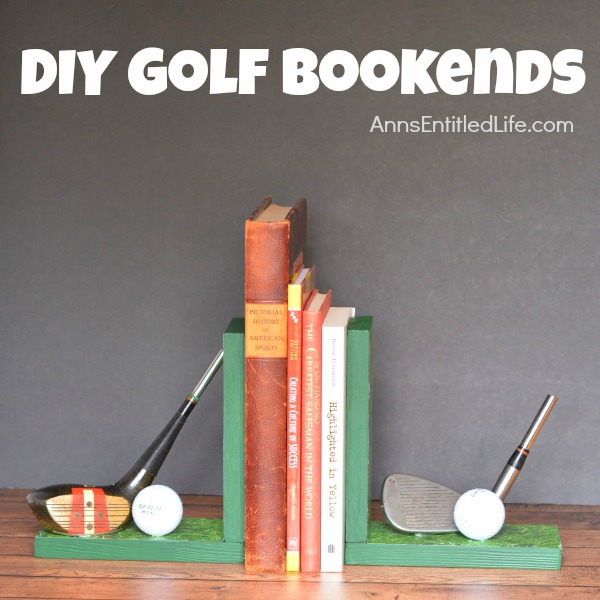



Didi says
That is so crafty!! If only I had the time!!
Ann says
You do, Didi, you do! 😛
Ann
Marie says
Omgosh, these would be perfect for Father’s Day! Thank you so much for sharing your awesome idea with us at Merry Monday this week!
Bre @ Average But Inspired says
SO clever! Love this great idea.
Ann says
Thanks, Bre 🙂
Ann
Abigail Cain says
Saving this idea as a Father’s Day gift. My hubby loves golf! 🙂
Ann says
I hope he likes it, Abigail!!
Ann